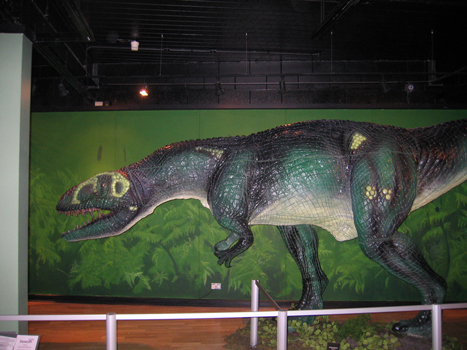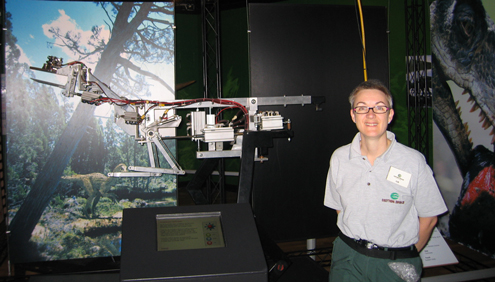Whithaven’s Beacon Welcomes Dinosaurs – A New Exhibition
BBC Walking with Dinosaurs Exhibition at the Beacon
The innovative Beacon museum at Whitehaven (Cumbria) has opened its summer dinosaur exhibition and the theme is prehistoric animals as they will be hosting the Walking with Dinosaurs exhibit – an opportunity for young palaeontologists and dinosaur enthusiasts of all ages to get up close to the likes of Triceratops and Tyrannosaurus rex.
Heralding the official opening, the enthusiastic staff at the Beacon held a press event last Friday evening, part of which involved testing the museum’s sound system and the roars of dinosaurs could be heard across the historic quayside.
Saturday was the official opening and television presenter and broadcaster Steve Leonard was on hand to perform the opening ceremony, cutting the red ribbon across the Beacon’s doors and an exhibition sixty-five million years in the making was underway. Team members from Everything Dinosaur had brought some fossils with them to show visitors and did their best to answer the many questions that were posed by the young and young-at-heart dinosaur fans.
The Beacon Museum at Whitehaven Promotes the Exhibition
![]()
Picture credit: Everything Dinosaur
The Beacon museum is a fascinating place to visit, with five floors jam packed with artefacts and relics that show Whitehaven’s past, there is even a super activity centre on the ground floor to accommodate school visits and permit lots of extension activities such as dinosaur crafts and mask making, which have been organised to accompany this dinosaur themed summer event.
It must have been quite a job trying to shoe-horn the Walking with Dinosaurs exhibition into the galleries, but the Beacon staff have managed to do it and they display the dinosaurs and the interactive elements associated with the exhibition in an imaginative way. For example, placing the cast of a skeleton of a peaceful, plant-eating Plateosaurus next to a Roman legionnaire in full battle dress.
Dinosaur Exhibition
Rather than conflict with each other, these two contrasting museum items seem to be getting along well. We did point out to the Beacon staff that Plateosaurus was a very geographically dispersed dinosaur, it roamed a significant proportion of what was to become the Roman Empire. We also explained that Roman legionnaires were blamed for littering much of the Italian landscape with the remains of their lunches – oyster shells and such like.
These were actually fossils of brachiopods and bivalves that had eroded out of the limestone formations from the surrounding hillsides. There is even a type of fossil brachiopod nick-named the “Roman Lamp” as the fossil resembles an oil lamp which was in widespread use during Roman times.
To us, it seems almost appropriate to station the Plateosaurus next to the Roman soldier.
The museum staff have laid out the dinosaur exhibits in chronological order, as much as possible. Starting on the fourth floor (the viewing gallery), there is a display of models from the television series that represent prehistoric animals from the Triassic, the dawn of the dinosaurs. In the display cases, beautifully preserved, carbonised plant fossils found around the Whitehaven area can be seen. These fossils pre-date the dinosaurs, they are actually over 300 million years old – (Pennsylvanian Epoch of the Carboniferous Period).
Descending down from the fourth floor it is like travelling forward in time some 150 million years. On the third floor, the remains of giant sauropods (long-necked dinosaurs) can be seen; giant Jurassic herbivores like Diplodocus and Brachiosaurus. On the second floor, you enter the Early Cretaceous, visiting the polar forests of Antarctica meeting the likes of the cute Leaellynasaura and the massive plant-eating iguanodontids, as well as pterosaurs such as Tapejara and Ornithocheirus.
One of the Giant Dinosaur Exhibits on Display at the Beacon (Life-size Megalosaurus)
Picture credit: Everything Dinosaur
On the first floor, you get the chance to see the last of the dinosaurs, those types of prehistoric animal that lived at the very end of the Cretaceous. Look out for the huge Triceratops skull and the T. rex lurking in readiness to ambush the unwary visitor. If you are lucky enough to visit the museum when Everything Dinosaur’s experts are on hand, you might get the chance to handle some real fossils and to pick the brains of our team – if there is something you have always wanted to know about dinosaurs – here’s your opportunity to find out.
We might even let in on one or two secrets, such as why do we call young dinosaur fan’s “munchkins” and Ankylosaurus’s claim to fame that you will not find publicised in any dinosaur book.
Everything Dinosaur team members will be at the museum on the following dates:
July – 9th and 10th
August – 13th and 14th
The Beacon museum is open daily from 10am to 5.30pm, with a last entry forty-five minutes before closing. Meals, snacks and refreshments are available from the Bistro which is on site and the Beacon museum staff have lots of dinosaur themed activities planned to help entertain (and educate) visitors to the museum over the next two months. For further details check the Everything Dinosaur blog.
The Walking with Dinosaurs exhibition runs until the 4th September, so catch it quick before the dinosaurs once again become extinct.
Everything Dinosaur’s Sue with one of the Animatronics on Display at the Museum
Picture credit: Everything Dinosaur
The picture shows Sue, standing next to one of the robotic frameworks used to bring to life the dinosaurs for the award winning television series – in this case a fearsome Utahraptor. Visitors to the Beacon can get the chance to operate this animatronic dinosaur themselves, just one of the many interactive elements to the exhibition.
Visit Everything Dinosaur’s award-winning website: Everything Dinosaur.



